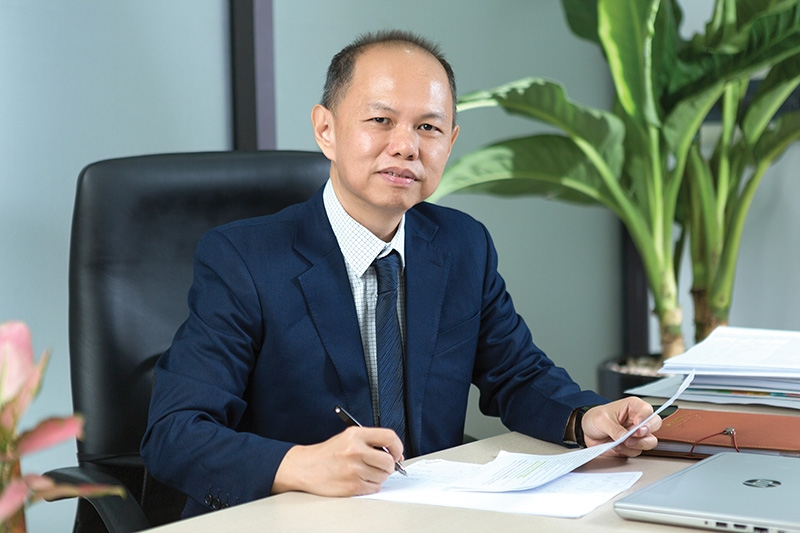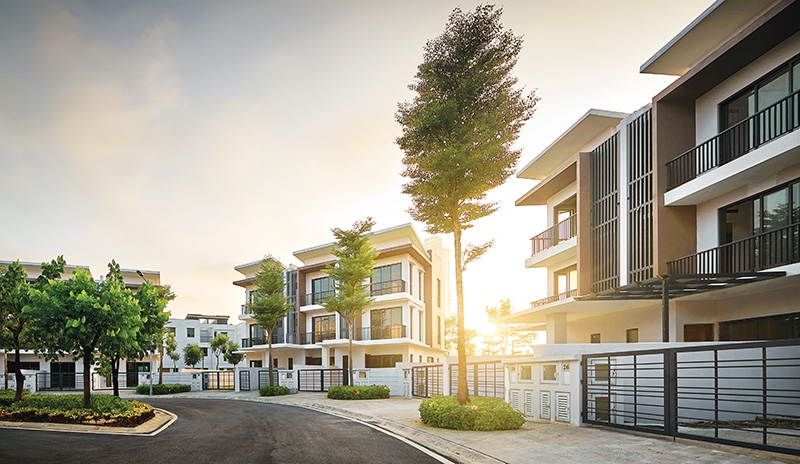Gamuda builds green oasis from ground up
 |
| Ng Teck Yow, general director of Gamuda Land Vietnam |
Since entering Vietnam more than 10 years ago, how would you evaluate your development in the country so far?
When I was posted in Vietnam, I was given a set of deliverables. These not only included business targets, many had social and community-related aspects and outlined a very clear development plan – one that we have been adhering to ever since.
Gamuda Bhd originally focused on infrastructure, real estate development was only later added to our operations and this past had a substantial impact on our development approach: the first step of our Gamuda project was not a residential but the Yen So Sewage Treatment Plant as the principle of our development strategy is always appreciating the surrounding environment since it forms the cornerstone for our community establishment, with this we can ensure the development of a sustainable township make possible.
Around 12 years ago, the area south of Hanoi was marshland filled by the Set, Kim Nguu, and To Lich rivers discharging sewage from greater Hanoi, carrying all of the capital’s waste. Realising that major traffic infrastructure would later on run through the area, Gamuda Land had decided to rely on Yen So Sewage Treatment Plant that was only a plan then to revitalise and rehabilitated the surrounding. To turn the area into a desirable place to live and work, Gamuda Land built the largest sewage treatment plant in Vietnam, which now deals with more than 30 per cent of the wastewater leaving Hanoi. The plant had a transformational impact on the whole southern area, giving it a new lease on life and addressing pressing environmental issues to the point where now live fish inhabit the lakes around Yen So Park.
The park itself, which is now touted as the “green lung” of the city, was also rehabilitated by Gamuda Land: we did the dredging, the soil treatment, and dislodged all unwelcome natural and man-made features to turn this heavily polluted area unfit for living into the green paradise we can offered today.
Only after this development we enter our next stage, the construction of the international-standard residential Gamuda Gardens, one of the four main precincts of Gamuda City (besides Yen So Park, Gamuda Central, and Gamuda Lakes). Little wonder apartments were bought up in a snap – as of today we have less than 30 apartments left at the project.
In the past 10 years, we have built a strong portfolio, including both high-quality residences and the accompanying amenities and infrastructure, and now pursue the second phase of our development plan: branding. We have been accumulating enough credentials to begin building our brand values and customer experience concepts: we always show customers what we can and have delivered – they need only to take a stroll around to see what we are all about, this is why we capitalised very much on customer experiences.
Gamuda Gardens, Celadon City, and especially Yen So Water Treatment Plant have all proven that Gamuda Land puts great stock in sustainable and community-oriented development in Vietnam. How are your projects building communities?
At Gamuda Land, we have a strongly holistic approach to development. We do not concentrate solely on the interior or the luxury features but strive to create a self-contained entity that can accommodate every need of its residential community. This is partly because the project lies on the fringes of Hanoi but also because that is what modern homebuyers and investors are looking for. Furthermore, our project is strategically located at the key designated area of Hanoi master plan that designed to combat urbanisation and address all issues caused by the development of a metropolitan city.
We are proud that Yen So Park is now the largest park, with also the largest lake inside a park in Hanoi. Unlike many other developers, we raise our trees and plants locally at Yen So Park, instead of importing them from abroad. This ensures that the plants are completely fit for the climate and that they do not suffer a potentially cultural shock when transplanted into the residential areas, with this it presents to the house owners and residents the local nature once they grow up in and intend to grow old with it.
We first created the park, then started working on other social infrastructure and facilities to await future residents – we partner with Singapore International School to place their headquarters at Gamuda Gardens, which was followed by a Montessori kindergartens, and other smaller educational units. Similarly, we collaborated with the leading local retailer VinMart to setup the first VinMart in the south, which is also the largest in the entire area with 3,000 square metres of supermarket convenience.
However, we never wanted Gamuda Gardens to be overly commercial. This is a residential project, not a commercial centre, so only a few banks and coffee shops were allowed inside to avoid unnecessary traffic. Everything beyond residents’ essential needs will be met at our upcoming Gamuda City, which will be the commercial centre connecting the surrounding residential elements. This way, the residential community will never need to travel far to have any needs met while at the same time enjoying a quiet neighbourhood for their daily lives.
 |
What is Gamuda Land’s development strategy in Vietnam?
First of all, our future plans revolve around two main pieces of land to be developed in the next 12-15 years. Gamuda Central will include a 8.4ha shopping mall land, residential apartments, festive retails, hotel and service apartments and office tower building, which is going to be right next to the metro station line 8.
As a general rule of thumb, there is great demand for offices next to metro stations in areas where there is hospitality, hotels, and serviced apartments. Gamuda Central itself will form the hub of the entire Gamuda City, the joint area, and the facilities of the whole ecosystem, following the suburb living concept suitable for the modern lifestyle.
This concept aligns with the main trends dictated by young citizens [those below 40], who make up close to three-quarters of the population. These younger generations are seeing increasing wealth and willingness to embrace change. With more of them able to afford cars and other vehicles, distance is starting to be less crucial, as long as the right infrastructure is in place. They do not mind travelling 30km on the highway, especially if it is faster than 10km in an inner-city traffic jam. And this is becoming a crucial consideration in property ownership: where can I save time, how can I get better services faster?
The transport system master plan of the project puts it within easy reach to Long Bien district and Hanoi-Haiphong Expressway via Thanh Tri Bridge, as well as to My Dinh area, Cau Giay district, and Nhat Tan Bridge via Ring Road 3, enabling Gamuda Central to become hub of southern Hanoi in the future.
The price of apartments verifies Gamuda’s strategy: our first showcase high-rise product was initially sold at $900 per square metre but has gone up to $1,300-1,400 with the new launched by now. Meanwhile, landed property in phase two was $2,000-2,200 per sq.m and is expected to reach $4,900 in the third phase. With this we can safely acknowledge the confidence that the buyers and homeowners have in us and strongly inspire us to grow stronger and better.
As a Malaysian developer in Vietnam, what potential do you think foreign investors see in the local real estate market?
Currently, most foreigners are still not thinking about settling here. Those who come to live here usually have a Vietnamese partner, but even apart from them, there have been foreign buyers at Gamuda projects coming from Singapore, Malaysia, China, Taiwan, and Hong Kong. We have just rolled out our last tower of 927 units, 300 of which have been sold to buyers from foreign countries. This confirms a new found appetite among Hong Kong buyers, in addition to Singaporean buyers who have already been paying attention to this project. These foreigners are looking at Vietnam as a consistently growing economy. While stable politics as well as administrative reforms are often praised, there is also social stability here that gives investors comfort, as Vietnam is one of the safer countries in the region.
The best thing that investors can see in Vietnam is a promising investment. They are not coming here to stay, but are looking for long-term property gains. Property prices are rising steadily and will continue to do so. In Ho Chi Minh City, $1,500-2,000 used to be expensive, but now a normal apartment costs about $3,000 per sq.m, and in an expensive area, they are talking about $7,000 – and these trends are set to continue and Hanoi to follow suit as it is the capital of the country.
The COVID-19 pandemic has affected the entire globe, with Vietnam being no exception. What solutions has Gamuda Land implemented to ensure business continuity and to keep business stable in Vietnam?
The pandemic has certainly affected our work but we have made every effort to keep our staff safe while ensuring smooth operations. In fact, we have closed our office for a month and asked our colleagues to work from home as we could not have large meetings of more than 30 people in the same place and strictly adhered to the government protocols.
The time was not wasted as not only did we manage to renovate our headquarters during this time but managed to roll out new ways of contacting customers by for example providing virtual consultancy and smart phone app that provide services and information update without direct contact.
One of the largest triumphs and most exciting projects we have worked on recently was the virtual launch of two of our six towers at Celadon City in Ho Chi Minh City. Not only were we able to go ahead with the launch while many others opted for delays due to the pandemic, we were also the first to stage a virtual launch in Vietnam that was highly accepted by the community in an unprecedented way.
The production process was a thrill as the event included both pre-prepared and live elements. Ensuring consistency and continuity in the final product made the work unique and entertaining – what with making sure I wear the same suit, down to the tie pin to look the same through the prepared and live segments.
The results were fantastic, more than 3,000 people watched the live stream, which is a very good turnout for a launching event, and found buyers for of the 600 units launched.
What the stars mean:
★ Poor ★ ★ Promising ★★★ Good ★★★★ Very good ★★★★★ Exceptional
Related Contents
Latest News
More News
- Sun Group breaks ground on $2 billion Van Don casino complex (December 19, 2025 | 18:14)
- Rare, beautiful, sustainable: the mark of iconic real estate (December 19, 2025 | 08:00)
- Owner-occupied housing stabilises, paving the way for new growth cycle (December 18, 2025 | 17:04)
- Unlocking urban potential of smart cities (December 18, 2025 | 16:50)
- Green finance offers 'passport' for Vietnamese construction, building materials firms (December 15, 2025 | 08:00)
- Gamuda Land commit long-term investment (December 12, 2025 | 11:49)
- HITC ties up with Evolution to develop AI and hyperscale data centres in Vietnam (December 11, 2025 | 12:09)
- Real estate deals boom via high-profile names (December 08, 2025 | 11:32)
- Industrial segment shaped by M&As (December 08, 2025 | 08:00)
- The Privé sets the benchmark for luxury real estate (December 05, 2025 | 08:28)

 Tag:
Tag:





















 Mobile Version
Mobile Version